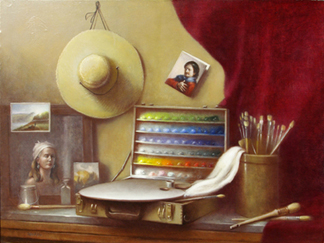Share |
Art: The Prismatic Palette
By Leslie Watkins
ART TIMES May/ June 2012
 "Homage to Frank", oil on linen. 30" x 40", "Homage to Frank", oil on linen. 30" x 40", by Leslie Watkins ©2012 |
The American Impressionist painter Frank Vincent DuMond (1865 -1951) developed the Prismatic Palette as an aid to instruct his landscape students. One of them, Frank Mason, claimed he had "perfect pitch," meaning that his sense of tonal value was so acute that he could perfectly "pitch" a painting. Mason further developed the palette and taught various mixing combinations. Using the Green Mountains of Vermont as his backdrop to illustrate the changing qualities of light in his plein air classes, Mason taught the Prismatic Palette to hundreds of his own students. I was one of them.
On May 31st, 1982 my friend Tom Torak picked me up from my apartment in NYC at 2AM. We drove all night to Stowe, Vermont and arrived on the Mountain Road at McCarthy’s just in time for breakfast. In the weeks that followed, Tom and other students gave me a crash course in making gesso panels, priming linen with lead, mixing and using the palette, and how to behave in Frank Mason’s landscape class. It was the beginning of what I consider my genuine life, as an artist. Up until then, everything else had been in preparation.I had studied at the Art Students League for several years, first artistic anatomy with Robert Beverly Hale, then ife drawing with Gustav Rehberger. I had attended cadaver dissection with Eliot Goldfinger at NYU’s Medical Center. I studied briefly with various instructors including Robert Phillipp, Thomas Fogarty, and Daniel Green, but it was with Frank Mason that I found an instructor who spoke to my nature loving, artistic heart.
Frank’s class was a master’s class in oil painting. Held in the afternoons in the north light of the League’s studio 7, it was more of an apprenticeship than a modern art class. There was a waiting list, or as in my case you were invited to enter. Once you were in, it could be years before you spoke casually with Frank, or even receive a critique. It was not uncommon for people to study with Frank for five years or more. The students who had studied longer were expected to help the new students get started. Frank rarely remembered someone’s name right off the bat. For the first three years I was “Sweetie”.
 The Prismatic Palette The Prismatic Palette |
My primary interest was in landscape painting. I attended Frank’s classes at the League, too, but it was all about heading north in June for me. The plein air instruction was based on the principle of atmospheric perspective, and used the palette as a means to simplify teaching it, and as a control for various types and times of day.
The Prismatic Palette makes plein air painting not easy, or simple. It is not a formula, or technique, but a way of thinking. It clarifies several strings of colors into even steps, with the lightest or highest values descending to the lowest or darkest tones. The steps are based on pure colors from cadmium lemon yellow to alizarin crimson. The different strings of colors consist of grays, violets, blues and greens.
The use of the palette facilitates the painting of landscapes in a variety of seasons and weather during various times of day: spring and fall, sunny and cloudy, sunrise and sunset, etc. By premixing values, one can paint deftly, accurately, and expressively, placing accurate tones of light and shade without having to test how the painting is pitched or keyed. In a very short time, one's palette can be readied to capture the fleeting passages of light.
The Prismatic Palette is much like a piano or organ for which each value or step serves as a note in an octave, yellow ocher being “middle C." When placed in the spatial dimension of the picture plane, each value or tone creates an accurate description of placement. Pleasing harmonies occur when two or three colors are placed among others, forming triads or complements. This is the basis of the Impressionist's technique of laying harmonious colors side by side, as in Monet's "Haystacks." By fusing the Belgian and Dutch glazing technique of adding transparent glazes of color with alla prima Impressionistic painting, even more luminosity can be achieved. This technique is especially effective for capturing brilliant sunrises and sunsets as demonstrated by Frederick Edwin Church in "Clouds over Olana" and "Sunset from Olana", and by Thomas Moran in "Bridal Veil Falls" in the collection of the Wadsworth Atheneum.
In plein air painting, the Prismatic Palette serves not only as a very effective tool for correctly judging values, but also to use warm and cool tones to bring things forward and to push things back, to depict light and shade, and to describe the type and time of day. By using full steps and half steps, it is possible to fine-tune your picture in infinite degrees. Soon, using the palette becomes second nature, making it possible to paint even in the dimmest light at the close of day. In time the ability to judge values becomes so finely honed that the palette is no longer necessary.
(Leslie Watkins, painter and teacher, is known for her landscape oils and botanical watercolors. Visit lesliewatkins.comfor information about her work, workshops and demonstrations throughout the United States and Europe.)
